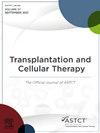The Association of HLA-E Ligand and NKG2 Receptor Variation With Relapse and Mortality After Haploidentical Related Donor Transplantation
IF 3.6
3区 医学
Q2 HEMATOLOGY
引用次数: 0
Abstract
Background
Recurrence of blood malignancy is the major cause of mortality after hematopoietic cell transplantation. NKG2 receptor/HLA-E ligand complexes play a fundamental role in the surveillance and elimination of transformed cells but their role in the control of leukemia in transplantation is unknown.
Objective
We tested the hypothesis that gene variation of patient and/or donor HLA-E ligand and donor NKG2C-NKG2A receptors are associated with the risks of relapse and mortality (primary endpoints) and GVHD and non-relapse mortality (secondary endpoints) after haploidentical transplantation.
Study Design
We retrospectively defined donor NKG2 receptor haplotypes and patient HLA-E ligands in 1629 haploidentical related transplantations. HLA-E residue 107 was genotyped in patients and donors. Single nucleotide polymorphisms descriptive of NKG2C and NKG2A haplotypes were characterized in donors. Overall mortality, relapse, nonrelapse mortality and chronic GVHD were studied using Cox regression models. Acute GVHD was studied by logistic regression.
Results
The hazard of relapse for patients transplanted from NKG2C-del/del donors was 51% lower than that from wt/wt donors (hazard ratio, HR, .49 [95% CI, .26 to .89) contributing to a HR for mortality of .62 (95% CI, .38 to 1.02). The HR of mortality among patients transplanted from a donor with 2 vs. 0 copies of the NKG2A rs35909400-rs2734440-rs12824474 CCC haplotype was HR 2.28 (95% CI, 1.34 to 3.86). The HRs of mortality for ArgArg and ArgGly patients compared to GlyGly patients were 1.42 (95% CI, 1.11 to 1.82) and 1.43 (95% CI, 1.13 to 1.81), respectively. Hazard ratios for nonrelapse mortality for patients with ArgGly or ArgArg genotypes compared to patients with GlyGly genotype were HR 1.60 (95% CI, 1.06 to 2.41) and HR 1.79 (95% CI, 1.21 to 2.66), respectively. Assessment of donor receptor/patient ligand pairings showed that among Arg-positive patients, the HR of mortality from donors with any wt-CCC/CCC haplotype was HR 2.52 (95% CI, 1.45 to 4.38) relative to donors with any wt-non CCC/CCC haplotype.
Conclusions
The success of haploidentical transplantation may be defined by the cumulative effects of donor NKG2 receptor and patient HLA-E ligand polymorphisms. Patient HLA-E ligand and donor NKG2C-NKG2A receptor haplotypes shed new light on their role in the control of malignancy.
HLA-E配体和NKG2受体变异与单倍体相关供体移植术后复发和死亡率的关系
背景:血液恶性肿瘤复发是造血细胞移植术后死亡的主要原因。NKG2受体/HLA-E配体复合物在监视和清除转化细胞中起着重要作用,但它们在移植中控制白血病中的作用尚不清楚。目的:我们验证了患者和/或供体HLA-E配体和供体NKG2C-NKG2A受体的基因变异与单倍体移植后GVHD的复发和死亡率(主要终点)以及GVHD和非复发死亡率(次要终点)相关的假设。研究设计:我们回顾性地定义了1629例单倍相同相关移植的供体NKG2受体单倍型和患者HLA-E配体。对患者和供体HLA-E残基107进行基因分型。在供体中发现了NKG2C和NKG2A单倍型的单核苷酸多态性。采用Cox回归模型研究总死亡率、复发率、非复发率和慢性GVHD。采用logistic回归对急性GVHD进行研究。结果:NKG2C-del/del供体移植患者的复发风险比wt/wt供体移植患者低51%(风险比,HR, 0.49[95%置信区间,CI, 0.26-0.89]),导致死亡率的HR为0.62 (95% CI, 0.38-1.02)。NKG2A rs35909400-rs2734440-rs12824474 CCC单倍型2拷贝和0拷贝供体移植患者的死亡率比为2.28 (95% CI, 1.34-3.86)。与GlyGly患者相比,ArgArg和ArgGly患者的死亡率hr分别为1.42 (95% CI, 1.11-1.82)和1.43 (95% CI, 1.13-1.81)。与GlyGly基因型患者相比,ArgGly或ArgArg基因型患者的非复发死亡率风险比分别为HR 1.60 (95% CI, 1.06-2.41)和HR 1.79 (95% CI, 1.21-2.66)。供体受体/患者配体配对评估显示,在arg阳性患者中,wt-CCC/CCC单倍型供体的死亡率相对于wt-非CCC/CCC单倍型供体的HR为2.52 (95% CI, 1.45-4.38)。结论:单倍体移植的成功可能取决于供体NKG2受体和患者HLA-E配体多态性的累积效应。患者HLA-E配体和供体NKG2C-NKG2A受体单倍型揭示了它们在恶性肿瘤控制中的作用。
本文章由计算机程序翻译,如有差异,请以英文原文为准。
求助全文
约1分钟内获得全文
求助全文
来源期刊

Transplantation and Cellular Therapy
Medicine-Hematology
CiteScore
7.00
自引率
15.60%
发文量
1061
审稿时长
51 days
 求助内容:
求助内容: 应助结果提醒方式:
应助结果提醒方式:


